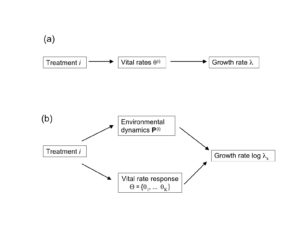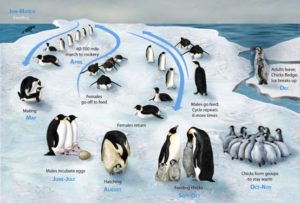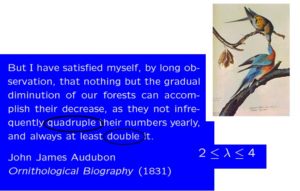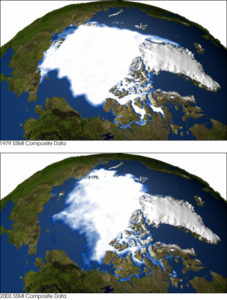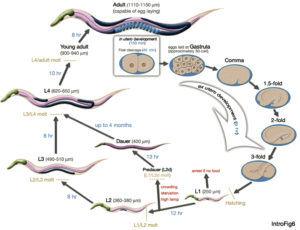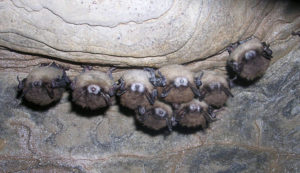Projects
In general, what am I interested in?
I work on mathematical ecological problems. Some of them are theoretical or analytical. Others involve the analysis of empirical data, in collaboration with (highly valued) collaborators. I tend to choose theoretical problems with empirical implications, and empirical problems that raise interesting theoretical issues. I do not limit myself to particular taxa or habitats. It's more fun that way. Because I have been working with them for a long time, many of my projects involve matrix population models. These are a particularly nice way to investigate the dynamics of structured populations (by age, by stage, or by other characteristics). But matrix models are not the only framework in which one can study structured populations, so I have no argument with the use of partial differential equations, renewal equations, delay differential equations, or integrodifference equations. I make frequent visits to the Max Planck Institute for Demographic Research in Rostock, Germany, where I interact with human demographers interested in biodemography.
Descriptions of some of my current projects appear below.
You can find references to publications on most of these projects on my CV elsewhere on this web page.
Perturbation analysis: sensitivity and elasticity in demography, Markov chains, and elsewhere
The results of any model always depend on the values of one or more parameters. Perturbation analysis examines the change in results that follows from a change in parameters. In demography, results are commonly expressed as sensitivities (the derivative of result y with respect to parameter x) or elasticities (the derivative of log y with respect to log x). I am actively working on extensions of perturbation analyses in
- matrix population models, including LTRE analysis for stochastic models, nonlinear matrix models for harvested populations and two-sex models, and other applications
- spatial models for invading populations
- models for stage-structured epidemics
- absorbing and ergodic Markov chains
Two-sex models: demography, invasions, and perturbation analysis
Collaborators:
Michael Neubert, Stephanie Jenouvrier
Believe it or not, most population models ignore sex. This strange omission works because, often, the reproductive output of females is not limited by the abundance of males. But when that assumption fails, both species must be included in a demographic model. Such models are inherently nonlinear, because the per-capita reproductive rate depends on the population structure. However, they are usually nonlinear in a way subtly different from the nonlinearities that arise from density-dependence, resource limitation, or predator-prey interactions: the models are homogeneous. That means that they depend only on relative proportions of the stages in the population, not the absolute abundance. My research on two-sex models is currently focusing on developing models to incorporate details of breeding behavior, on perturbation analysis of population structure and growth rate, and on the effect on the speed and success of biological invasions.
Perturbation analysis of longevity
Longevity is a fundamental demographic property. Human demographers are fascinated by it partly because it describes how long human demographers (among others) live, and partly because it has undergone historically unprecedented increases in the last 200 years. Evolutionary demographers are fascinated by it because it reflects, at least partly, the action of senescence, which for more than half a century has been the canonical problem of life history evolution. Population ecologists are at least mildly interested in it because it summarizes mortality patterns and influences population growth, recovery, and introductions.
My research on longevity uses Markov chain theory to develop new indices of longevity, especially for complex stage-structured (or age x stage-structured) life cycles. Given the indices, I then use matrix calculus to explore the sensitivity and elasticity of longevity to demographic parameters.
Demography of species of conservation concern
Collaborators:
Christine Hunter, Stephanie Jenouvrier, Richard Lawler, Carly Strasser
Conservation is, in essence, a demographic problem. There is no endangered species that could not be transformed into a pest species by the application of a little positive exponential growth. Hence, understanding the growth potential, the factors that limit it, and the potential of management actions to influence it, are critical to conservation. My laboratory has a long tradition of producing demographic analysis of threatened or endangered species. I look for cases that are likely to lead to new theoretical or analytical developments, and where collaborators with interesting data sets can be found. Recent examples include
- the North Atlantic right whale
- the polar bear
- Verreaux's sifaka (a lemur; really cute)
- the emperor penguin
- several species of albatrosses and other seabirds
- endangered terrestrial plants, including Boltonia decurrens in the flood plain of the Illinois River, and Lomatium bradshawii in prairies in Oregon.
Recently, these projects have developed a focus on effects of climate change, described here as another project.
Population responses to climate change
The response of a population to climate change is mediated through its demographic responses to changes in environmental variables. My recent research on polar bears and penguins has focused on responses to changes in sea ice conditions, but other variables will be important in other species and/or locations. I am working to develop a general framework to permit the development and analysis of population models to explore the consequences of climate change, including stochasticity, perturbation analysis, and uncertainty analysis.
Demography and ecology of Caenorhabditis elegans
Collaborators:
Ed Caswell-Chen (UC Davis)
Caenorhabditis elegans is everyone's favorite nematode; it serves as a model organism for studies in developmental genetics, including the biology of aging. A number of mutants have been identified that dramatically affect age-specific survival and longevity in the laboratory, and I have developed several matrix population models to examine these effects. However, C. elegans certainly did not evolve in an environment even remotely similar to that in which it lives in the laboratory. I am interested in exploring the consequences of its ecological environment on the demography and life history evolution of this species. Such analyses could be of great theoretical interest, as well as informing empirical studies of aging.
Stage-structured models of epidemics
Collaborators:
Petra Klepac, Catherine Nosova
Epidemic models classify individuals by their infection status (infected, susceptible, recovered, etc.). Demographic models classify individuals by their demographic status (age, stage, reproductive status, etc.). But epidemic processes can obviously depend on demographic status, and demographic processes can equally depend on infection status. This suggests the importance of stage-structured epidemic models, where the population changes over time in response to both kinds of processes. I am working on developing models for stage-structured epidemics, and for determining net reproductive numbers, perturbation analysis, and dynamic consequences.

